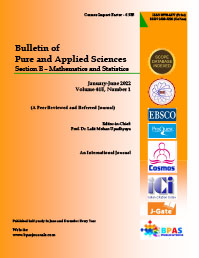Usage of the finite difference method for solving one-dimensional heat equations ∗
DOI:
https://doi.org/10.48165/Keywords:
Finite difference method, One-dimensional heat equation, Uniqueness and stabilityAbstract
In this paper the one-dimensional heat equations with the heat generation arising in the associated fractal transient conduction is investigated. Analytical solutions are obtained by using the finite difference method (FDM). The method, in general, is easy to implement and it yields good results. In addition, the uniqueness and stability results are also discussed. Some illustrative examples are included to demonstrate the validity and applicability of the technique.
References
Ames, W.F. (1992). Numerical Methods for Partial Differential Equations, Academic Press, Inc., Boston, third edition.
Aslak T. and Ragnar, W. (2005). Introduction to partial differential equations: a computational approach, Springer Verlag, New York.
Atshan, S. and Hamoud, A. (2018). Approximate solutions of fourth-order fractional integrodif ferential equations, Acta Universitatis Apulensis, 55(3), 49–61.
Beghr, H. and Harutyunyan, G. (2006). Robin boundary value problem for the Poisson equation, J. Anal. Appl., 4(3), 201–213.
Beghr, H., Saule, B. and Harutjunjan, G. (2017). Remark on Robin problem for Poisson equation, Complex Variables and Elliptic Equations - An International Journal, 62(10), 1589–1599. https: //doi.org/10.1080/17476933.2017.1303052
Burden, R.L. and Faires, J.D. (1997). Numerical Analysis, sixth edition, Brooks/Cole Publishing Co., New York.
Bourchra, B., Guillaume, C. and Jacques, L. (2015). Penalization of Robin boundary condition, Applied Numerical Mathematics, 96(2015), 134–152. https://doi.org/10.1016/j.apnum.2015. 06.001
Cho, C.H. and Okamoto, H. (2020). Finite difference schemes for an axisymmetric nonlinear heat equation with blow-up, Electronic Transactions on Numerical Analysis, 52(2), 391–415. [9] Cooper, J. (1998). Introduction to Partial Differential Equations with Matlab, Birkhäuser, Boston. [10] Fletcher, C.A. (1988). Computational Techniques for Fluid Dynamics, Springer-Verlag, Berlin. [11] Ghadle, K.P., Hamoud, A.A. and Issa, M.S.B. (2018). A comparative study of variational iter ation and Adomian decomposition techniques for solving Volterra integro-differential equations, International Journal of Mathematics Trends and Technology, 64(2), 16–21.
Golub, G. and Ortega, J.M. (1993). Scientific Computing: An Introduction with Parallel Com puting, Academic Press, Inc., Boston.
Hamoud, A. and Ghadle, K. (2018). Modified Adomian decomposition method for solving fuzzy Volterra-Fredholm integral equations, J. Indian Math. Soc., 85(1-2), 52–69.
Hamoud, A. and Ghadle, K. (2017). The reliable modified of Laplace Adomian decomposition method to solve nonlinear interval Volterra-Fredholm integral equations, The Korean Journal of Mathematics, 25(3), 323–334.
Hamoud, A.A., Mohammed, N.M. and Ghadle, K.P. (2019). Solving FIDEs by using semi analytical techniques, Communications in Advanced Mathematical Sciences, 2(3), 192–198. [16] Hinze, M., Pinnau, R., Ulbrich, M. and Ulbrich, S. (2009). Mathematical modelling: Theory and Applications, Springer. https://doi.org/10.1007/978-1-4020-8839-1
Hoffman, J.D. (1992). Numerical Methods for Engineers and Scientists, McGraw- Hill, New York. [18] Isaacson, E. and Keller, H. (1994). Analysis of Numerical Methods, Dover, New York. [19] John, C.S. (2004). Finite Difference Schemes and Partial Differential Equations, second edition, SIAM, Philadelphia. https://doi.org/10.1137/1.9780898717938
Kreyszig, E. (1993). Advanced Engineering Mathematics, seventh edition, Wiley, New York. [21] Lu, X., Tervola, P. and Viljanen, M. (2005). An efficient analytical solution to the transient heat conduction in one dimensional hollow composite cylinder, J. Phy. A. Math. Gen. 38(47), 10145–10155. 98 Kirtiwant P. Ghadle, Malayin A. Mohammed and Aishwary K. Ghadle
Morton, K.W. and Mayers, D.F. (1994). Numerical Solution of Partial Differential Equations: An Introduction, Cambridge University Press, Cambridge, England.
Monte, F. (2000). Transient heat conduction in one-dimensional composite slab: a natural analytic approach, International Journal of Heat and Mass Transfer, 43(19), 3607–3619. [24] Peter, K. and Lutz, A. (2000). Numerical methods for elliptic and parabolic partial differential equations, second edition, Springer, New York. https://doi.org/10.1007/b97419 [25] Thomas, J.W. (1995). Numerical Partial Diffential Equations: Finite Difference Methods, Springer, New York. https://doi.org/10.1007/978-1-4899-7278
